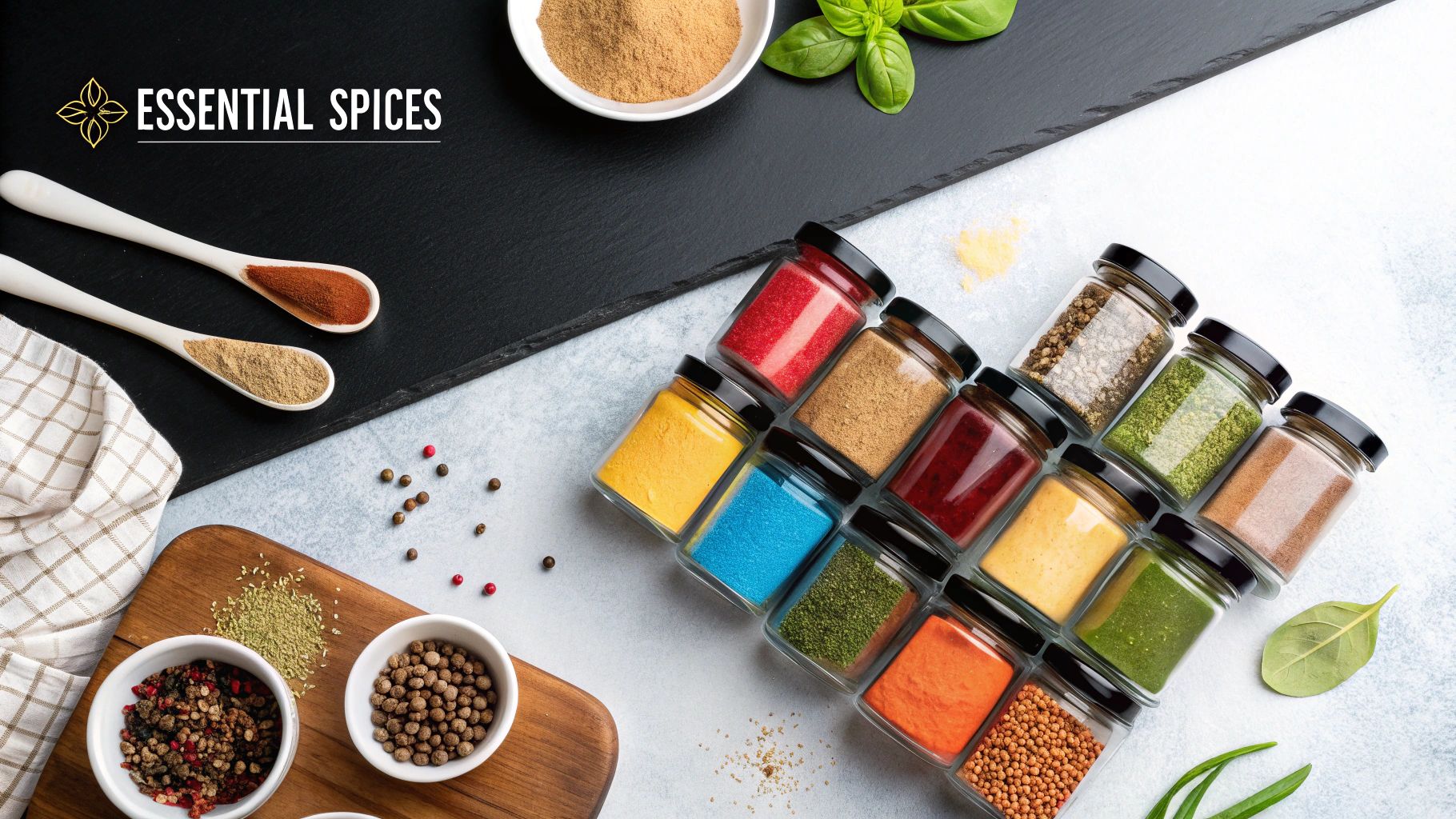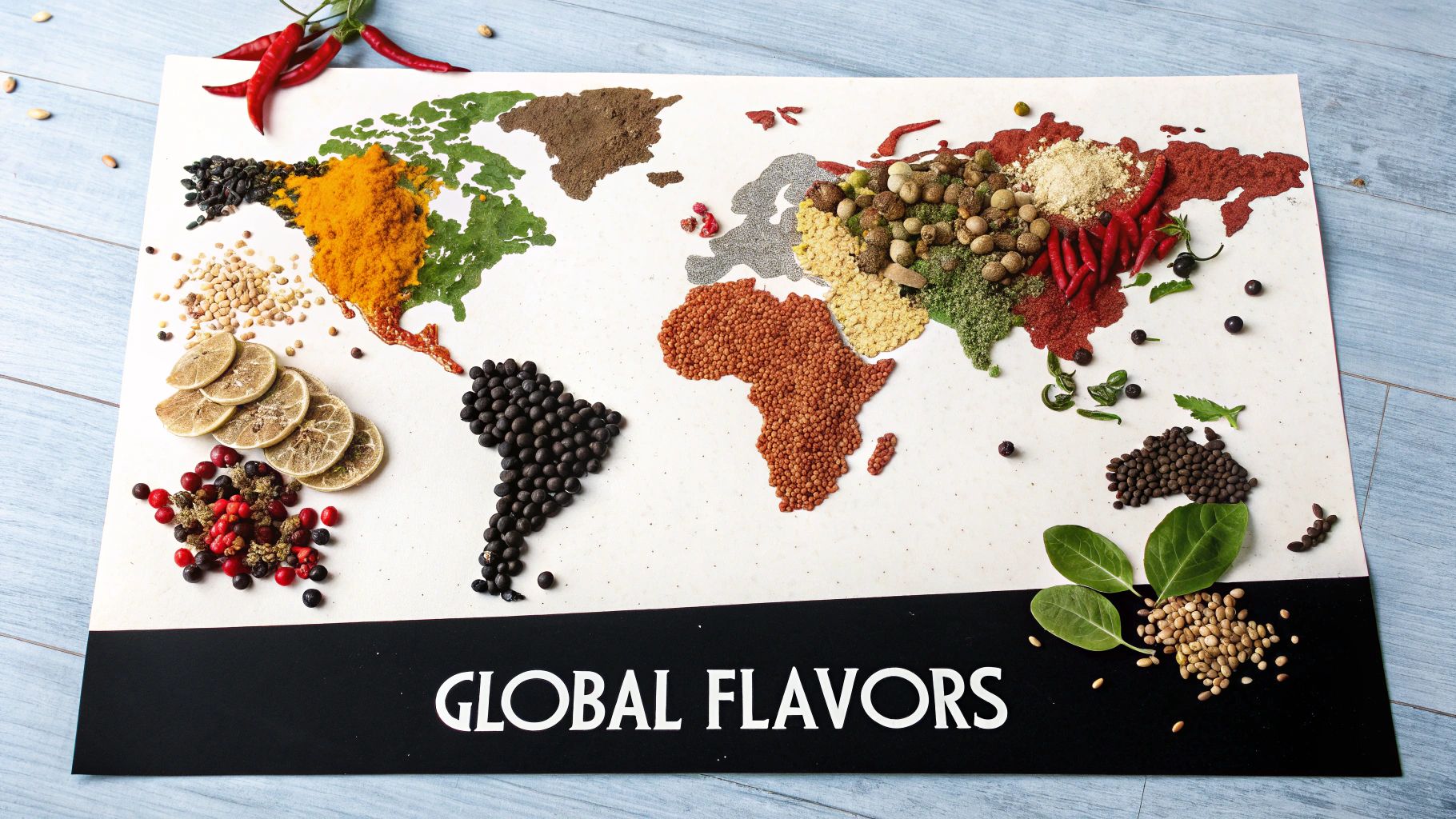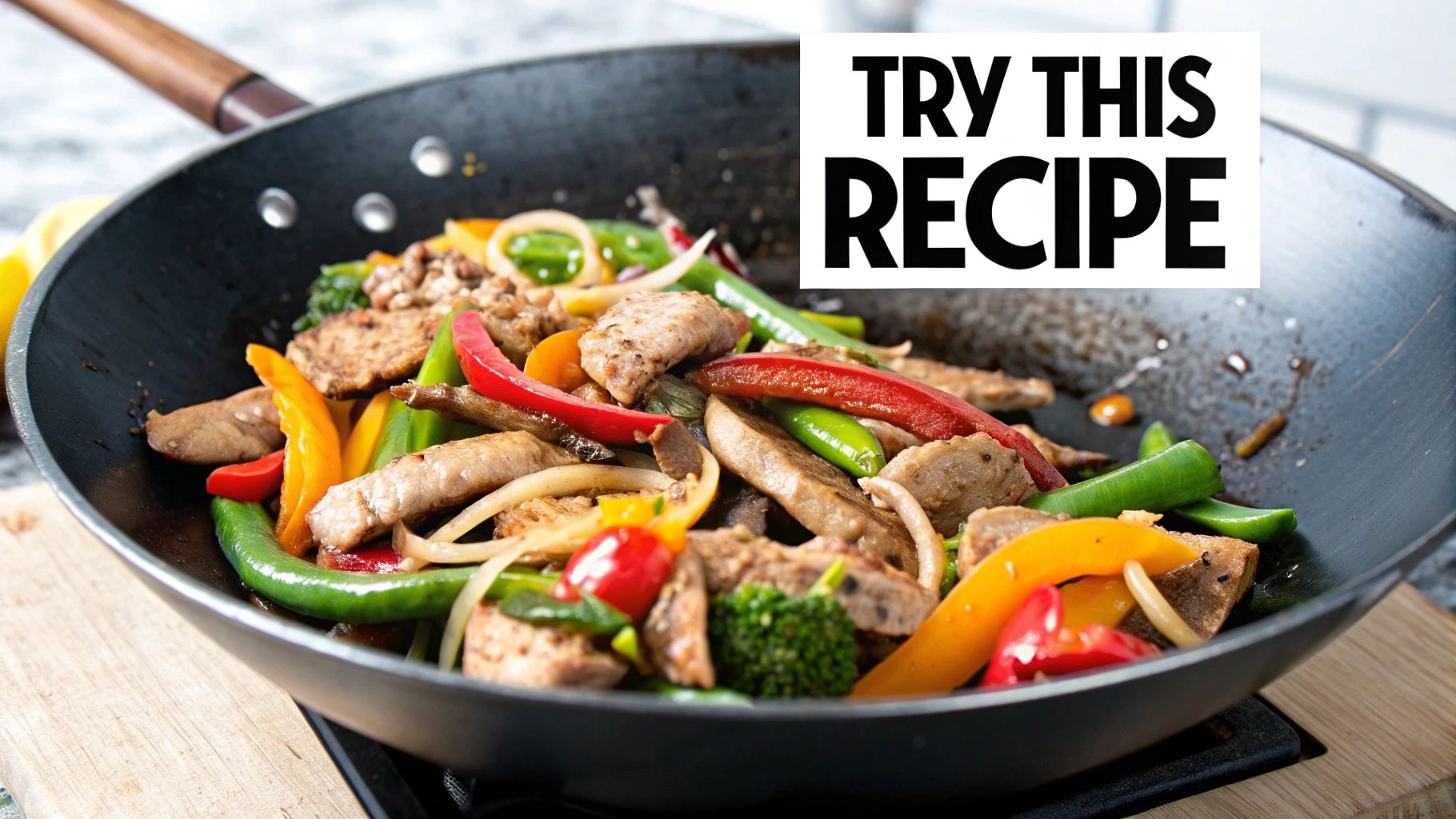The Best Spices for Stir Fry Success
Ever wondered why your homemade stir-fry tastes a bit… flat? You’ve got all the right ingredients, the wok is sizzling, but the final dish just doesn’t have that flavour explosion you get from a great takeaway.
The secret isn’t some mystical technique. It’s all about balance, and it’s easier than you think. The best stir-fries are built on four key flavour pillars: aromatics, savoury depth, warmth, and a touch of sweetness. Master these, and you’ll transform your stir-fry game for good. This isn't just about what spices to use; it's about how to use them to get that authentic, flavour-packed result every single time.
The Foundation of Stir-Fry Flavour
Let’s get one thing straight: moving beyond a bland stir-fry has nothing to do with chucking in more ingredients. It’s about building layers of flavour from the ground up, just like a professional chef would. At Smokey Rebel, we're all about authentic cultural flavours with no added crap, and that starts with understanding the fundamentals.
Think of these four pillars as your non-negotiables. Get them right, and any combination of protein and veg you throw in the wok will taste incredible. This isn’t about complicated recipes; it’s about a simple, powerful framework that delivers every single time.
Understanding the Flavour Pillars
Picture these pillars as the core members of a band. Each one plays a crucial part, and when they work together, you get a masterpiece. If one is missing or overpowering the others, the whole thing falls apart. A stir-fry that’s just salty is boring. One that’s all heat and no depth is forgettable.
Here’s a quick look at the role each pillar plays:
- Aromatics: These are the first things to hit the hot oil, filling your kitchen with that incredible smell. They’re the fresh, pungent punch that wakes everything up. Think garlic, ginger, and spring onions.
- Savoury Depth (Umami): This is the rich, meaty backbone of the dish. It’s the satisfying, moreish flavour that makes you dive back in for another mouthful. Soy sauce is the classic, but things like oyster sauce or our Street Food seasoning take it to another level.
- Warming Spices: This isn’t just about blow-your-head-off heat. Warming spices add complexity and a gentle, lingering heat that complements everything else. Think white pepper, Chinese five-spice, or a dash of chilli flakes.
- Sweetness: A tiny bit of sweetness is the secret weapon. It’s not there to make the dish sugary, but to round out the sharp, salty flavours and bring everything into perfect harmony. A pinch of sugar or a touch of honey does the trick.
Once you get a feel for how these four elements work together, you can stop following recipes and start creating your own signature dishes. That's the real goal, isn't it?
To make it even clearer, here’s a quick summary of the essential components you need for a perfectly balanced stir-fry.
The Four Pillars of Stir Fry Flavour
| Flavor Pillar | Role in Stir Fry | Common Spice Examples |
|---|---|---|
| Aromatics | Creates the fragrant, pungent base. | Garlic, ginger, spring onions, chillies, shallots |
| Savoury Depth | Provides the rich, satisfying umami foundation. | Soy sauce, fish sauce, miso paste, Street Food Seasoning |
| Warming Spices | Adds complexity and gentle, lingering heat. | White pepper, Chinese five-spice, star anise, Szechuan peppercorns |
| Sweetness | Balances the salty and savoury notes. | A pinch of sugar, honey, mirin, or sweet soy sauce |
Nailing the interplay between these four pillars is what separates an average home-cooked meal from something truly special. It’s a simple framework that, once you understand it, gives you the freedom to improvise with confidence.
Building Your Essential Stir Fry Spice Pantry

Let's be honest, a great stir-fry starts long before anything hits the wok. It starts in your pantry. But you don't need a hundred different jars to make something incredible. It's all about mastering a core team of powerhouse spices that form the backbone of countless dishes.
Think of it like building a flavour dream team. Each ingredient has a specific job, and when they work together, that's when the magic happens. Let's get your toolkit sorted.
The Aromatic All-Stars
These are the fresh, punchy ingredients you throw into the hot wok first. That initial sizzle and incredible smell? That's your flavour base being born, and it's absolutely non-negotiable for an authentic taste.
- Fresh Ginger: Please, don't even think about using the powdered stuff here. Freshly grated or minced ginger delivers a zesty, almost fiery warmth that beautifully cuts through rich sauces and fatty bits of meat. That clean, sharp bite is indispensable.
- Garlic: The ultimate savoury foundation. Whether you slice it, mince it, or give it a good crush, garlic brings a deep, pungent kick that mellows into a gorgeous sweet, nutty flavour as it cooks. It's the real workhorse of your stir-fry pantry.
Peppers: The Backbone of Heat and Earthiness
The pepper you choose will completely change the personality of your dish. It's not just about adding heat; it’s about the character of that heat.
Pro Tip: For a perfectly balanced base of salt, pepper, and garlic, a top-notch SPG blend is a brilliant shortcut. This simple trio is way more versatile in Asian cooking than you might think, giving you a solid starting point before you layer on more complex spices. For more ideas, check out our guide on how to use SPG seasoning on everything.
White and black pepper come from the same plant but are treated differently, giving them totally distinct personalities.
- White Pepper: This is the classic choice in a huge number of Chinese recipes. It has an earthy, almost funky heat that builds slowly on the palate. It adds warmth without the sharp, floral notes of its black counterpart, which lets all the other flavours really shine through.
- Black Pepper: This one brings a sharper, more immediate heat with punchy, fruity notes. It’s fantastic in bolder dishes like black pepper beef, where you want its assertive character to be the star of the show.
Spices for Depth and Complexity
Once you've got your aromatics and heat sorted, these dried spices are what add those fascinating layers of character. They’re the secret weapon that takes a stir-fry from "good" to "unforgettable".
- Star Anise: This beautiful, star-shaped spice gives off a deep, sweet, liquorice-like aroma. Pop a whole one into braised dishes or rich, slow-simmering sauces to build a complex, warming background note. Trust me, a little goes a very long way.
- Chinese Five-Spice: This isn't just one spice; it's a masterful blend that usually includes star anise, cloves, Chinese cinnamon, Sichuan peppercorns, and fennel seeds. It’s designed to hit all five flavour notes—sweet, sour, bitter, salty, and umami—giving your food instant complexity and that classic, fragrant warmth.
How to Properly Layer Spices for Maximum Flavour
One of the biggest mistakes people make with stir-fries is just chucking the spices in at the end. You're leaving a mountain of flavour on the table that way. The real magic happens when you “bloom” your spices — a simple trick that uses hot oil to unlock their deepest, most aromatic compounds.
Think of it like toasting nuts or seeds. A little bit of heat is all it takes to go from good to incredible.
This whole process creates a fragrant, powerful base before you even think about adding your meat or veg. Honestly, mastering this one step is the difference between a flat, one-note stir-fry and one that explodes with complexity. It’s a total game-changer for getting that authentic takeaway taste at home.
The Art of Blooming Spices: A 2-Minute Guide
Blooming is all about timing and temperature. You need the oil hot enough to coax out the essential oils from the spices, but not so scorching that they burn and turn bitter. It only takes a few moments, but it pays off massively in the final dish.
This little infographic shows how common stir-fry spices don't just add flavour, but also bring some pretty great health benefits to the party.

As you can see, things like turmeric, ginger, and garlic are functional powerhouses. They make your flavour base both delicious and beneficial.
Here’s a dead simple, step-by-step guide to get it right every time:
- Heat Your Oil: Get your wok nice and hot over a medium-high heat with a neutral oil like rapeseed or peanut. You’ll know it’s ready when the surface just starts to shimmer.
- Add Fresh Aromatics: In go your hard, fresh aromatics first. We’re talking about minced ginger and garlic. Stir them constantly for about 30 seconds until the kitchen smells amazing. Don’t let them brown, or they’ll taste acrid.
- Bloom the Dried Spices: Knock the heat down to medium and add your ground spices — think white pepper, turmeric, or a good five-spice blend. Keep stirring for another 15-20 seconds. The spices will release their aroma, and the oil will start to take on their colour.
This layering process is key. It makes sure every single component is cooked perfectly. Fresh aromatics need a bit more time to release their goodness, while delicate ground spices can burn in a flash. By adding them in the right order, you build a foundation of flavour that will soak into the entire dish.
Once your spices are bloomed, you’re ready to get your protein and veg in the wok. They’ll absorb all that intensely flavourful oil, making sure every single bite is packed with deliciousness.
This technique is a winner for all sorts of dishes, especially beef stir-fries. For more ideas on that front, check out our guide on what spices go well with beef.
Creating Your Own Signature Stir Fry Spice Blends

Ready to go beyond chucking in a pinch of this and a dash of that? Making your own signature spice blend is where the real fun begins. It’s your chance to take control and dial in the heat, warmth, and fragrance to get the exact flavour you’re chasing.
It’s no secret that we all love a quick, flavour-packed meal, and the numbers back it up. In the UK, spending on chilled stir-fry kits has shot up as more of us look for authentic ethnic flavours without the faff. Crafting your own spice blend plugs you straight into that vibe, giving you restaurant-level results from your own kitchen.
Classic Five-Spice Blend Recipe
This is the absolute cornerstone of so many Chinese dishes. It’s a complex, aromatic blend that hits you with a wave of sweet and savoury warmth, designed to touch on all five flavour notes for instant depth.
-
The Ratio:
- 2 tsp ground cinnamon
- 2 tsp ground star anise
- 1 tsp ground fennel seeds
- 1 tsp ground cloves
- ½ tsp ground Sichuan peppercorns (or white pepper if you must)
- Flavour Profile: Warm, sweet, and aromatic with that classic hint of liquorice.
- Best For: Richer meats like pork belly, duck, and beef. It’s also an absolute game-changer as a dry rub for chicken wings before they hit the air fryer.
Vibrant Southeast Asian Blend Recipe
Drawing inspiration from the bright, zesty flavours of Thailand and Vietnam, this blend is all about freshness. It’s fragrant, a little bit earthy, and brings a real summery lift that cuts right through rich dishes.
-
The Ratio:
- 2 tsp ground turmeric
- 2 tsp ground coriander
- 1 tsp ground ginger
- 1 tsp garlic powder
- ½ tsp dried lemongrass powder
- Flavour Profile: Bright, citrusy, and earthy with a stunning golden colour.
- Best For: Chicken, prawns, and fish. It’s also brilliant with lighter veggies like pak choi, peppers, and mangetout for a quick, healthy meal. For more chicken marinade ideas, check out our guide on creating a honey soy marinade for chicken.
Sichuan-Inspired Numbing Heat Blend Recipe
Right, this one is for the flavour adventurers. It’s built around the famous ma la (numbing and spicy) sensation from Sichuan cooking, delivering a tingly heat that’s totally unique.
This isn't just about blowing your head off with heat; it's a multi-layered experience. The Sichuan peppercorns create this incredible tingling, almost buzzing sensation on your tongue that makes the chilli heat feel even bigger and more flavourful.
-
The Ratio:
- 2 tsp ground dried chillies (or chilli flakes)
- 1.5 tsp ground Sichuan peppercorns
- 1 tsp cumin powder
- ½ tsp white pepper
- Flavour Profile: A bold, fiery kick followed by that unmistakable, mouth-numbing tingle.
- Best For: Beef, lamb, and tofu. This blend absolutely sings in dishes with rich, oily sauces that can carry its powerful flavour.
Of course, if you want that perfectly balanced, authentic taste without any of the guesswork, a top-notch pre-made blend is your best mate. Our craft seasonings, packed in our signature tins, deliver complex, aromatic flavour with no junk, making it ridiculously easy to create a stir-fry masterpiece every single time.
Exploring Advanced Spices and Flavour Twists
Right, you’ve nailed the basics. Now it’s time to get a bit more adventurous. For the flavour pioneers out there who are ready to push the boat out, a few advanced spices can turn a great stir-fry into something genuinely unforgettable. This is where you add layers of complexity that really set your cooking apart.
Think of it like adding a turbocharger to your engine. The car runs fine, but with that extra boost, it becomes something else entirely—a thrilling new level of performance. This is where you can start to innovate and find your own signature style.
The Tingle of Sichuan Peppercorns
Let’s kick things off with one of the most unique spices on the planet: the Sichuan peppercorn. This isn't about heat in the way you think of chilli. It’s about a fascinating, mouth-numbing tingle known as ma la. This buzzing sensation almost primes your palate, making every other flavour in the dish—from the chilli to the savoury sauces—pop even more.
To get the most out of them, they need a little bit of prep.
- Toast Them: Gently toast whole peppercorns in a dry pan over a low heat for 2-3 minutes. You’ll know they’re ready when the aroma hits you.
- Grind Them: Let them cool down completely, then give them a quick blitz in a spice grinder or go old-school with a mortar and pestle.
Just a pinch of this fresh powder added near the end of cooking is all you need for that signature tingle. It's a total game-changer, especially with beef and lamb stir-fries.
Smoky Depth with Black Cardamom
While green cardamom is floral and sweet, its bigger, darker cousin is a completely different beast. Black cardamom is dried over an open flame, giving it a powerful, smoky, almost medicinal aroma with hints of camphor and menthol.
Because its flavour is so bold, a little goes a very long way. Use it in rich, hearty stir-fries with things like pork or mushrooms, where its intensity can stand up to other robust ingredients. Just crack a pod open, let it simmer in your sauce, and pull it out before you serve.
Unconventional Twists for the Flavour Pioneer
This is where your BBQ instincts can really come into play. Blurring the lines between classic Asian spices and smokehouse flavours is how you create something really special. It’s about breaking the rules with a bit of purpose.
- Smoked Paprika: A tiny pinch adds a subtle, smoky warmth that works beautifully with chicken or prawn stir-fries. It brings in that familiar BBQ note without steamrolling the whole dish.
- Ground Coriander: Common in loads of cuisines but often overlooked in stir-fries. Its bright, citrusy, and slightly floral notes add a fresh lift that’s brilliant with lighter veg and chicken.
By weaving in these unexpected spices, you’re creating signature dishes that are truly yours—packed with clean, complex flavour and absolutely no added crap.
Frequently Asked Questions About Stir-Fry Spices

What are the 3 essential spices for any stir fry?
If you're building a stir-fry from the ground up, the non-negotiable trio is garlic, ginger, and spring onions. They are the foundational heartbeat of your dish. Garlic brings a pungent, savoury base; ginger adds a zesty, citrusy warmth; and the white parts of spring onions provide a mild, sweet onion flavour. Master this trio, and you've got a powerful flavour base for any protein or vegetable.
How can I fix a bland stir fry in 60 seconds?
A bland stir-fry is easy to rescue. First, add a splash of soy sauce for umami depth. Next, squeeze in a bit of fresh lime juice or a dash of rice vinegar to make all the other flavours pop. Finally, kill the heat and drizzle in a teaspoon of toasted sesame oil for an instant, powerful nutty aroma. This three-step fix takes less than a minute.
Should I use fresh or ground spices in a stir fry?
For core aromatics like garlic and ginger, fresh is always better—the vibrant, potent flavour is something powders just can’t replicate. For warming spices like white pepper, star anise, or Chinese five-spice, high-quality ground versions are brilliant for blooming in hot oil to release their essential oils. This love for diverse spices is growing, with UK consumption projected to hit around 72,000 metric tons by 2028 (read more about UK spice consumption trends).
What's the best way to add heat to a stir fry?
For a clean, sharp heat, add fresh sliced chillies along with your garlic and ginger. For a deeper, lingering warmth, use dried chilli flakes or a pinch of white pepper when you bloom your dried spices. For a more complex, tingling heat, try ground Sichuan peppercorns added near the end of cooking.
At Smokey Rebel, we believe flavour should never be complicated. Our craft seasonings are made with authentic ingredients and absolutely no added crap, so you can create incredible stir-fries with total confidence.
Explore our range of rubs and seasonings to find your next secret weapon.
Join our Mailing List
Sign up and get Smokey Rebel Recipes + weekly recipes straight to your inbox!
Recent articles
Unlocking Flavour with Meat Rub Seasoning
Discover how meat rub seasoning transforms your cooking. Learn how to choose, apply, and master rubs for incredible BBQ, from...
Read moreHow to Make BBQ Seasoning at Home
Learn how to make BBQ seasoning with our expert guide. Discover the perfect ingredient ratios and recipes to elevate your...
Read morePerfect Gift Set Spices for Every BBQ and Kitchen Occasion
Find the ideal gift set spices with tips on flavor profiles, pairings, and cooking ideas. Perfect for BBQ lovers and...
Read more


